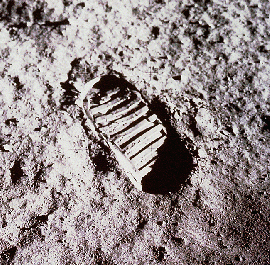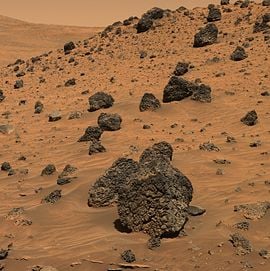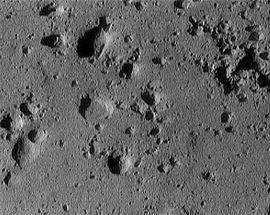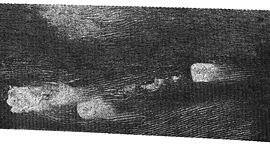Regolith
Regolith (Greek: "blanket rock") is a layer of loose, heterogeneous material covering solid rock. It includes dust, soil, broken rock, and other related materials and is present on Earth, the Moon, some asteroids, and other planets. The term was first defined by George P. Merrill in 1897 who stated, "In places this covering is made up of material originating through rock-weathering or plant growth in situ. In other instances it is of fragmental and more or less decomposed matter drifted by wind, water or ice from other sources. This entire mantle of unconsolidated material, whatever its nature or origin, it is proposed to call the regolith."[1]
On the Earth
On Earth, the regolith[2][3][4] is composed of the following subdivisions and components;
- Soil or pedolith
- Alluvium and other transported cover, including that transported by aeolian, glacial, marine, and gravity flow processes.
- Saprolith, generally divided into the
- Upper saprolite: completely oxidised bedrock
- Lower saprolite: chemically reduced partially weathered rocks
- Saprock: fractured bedrock with weathering restricted to fracture margins.
- Volcanic ash and lavas
- Duricrust, formed by cementation of soils, saprolith and transported material by clays, silicates, iron oxides and oxyhydroxides, carbonates and sulfates, as well as less common agents, into indurated layers resistent to weathering and erosion.
- Groundwater and water-deposited salts.
- Biota and organic components derived from it.
Regolith can vary from being essentially absent to hundreds of metres in thickness. Its age can vary from instananeous, for an ash fall or alluvium just deposited, to hundreds of millions of years old. Regolith of Precambrian age has been found in parts of Australia.[5]
The origins of regolith on Earth are weathering and biological processes; if it contains a significant proportion of biological compounds it is more conventionally referred to as soil. People also call various types of earthly regolith by such names as dirt, dust, gravel, sand, and (when wet) mud.
On Earth, the presence of regolith is one of the important factors for most life, since few plants can grow on or within solid rock and animals would be unable to burrow or build shelter without loose material.
Regolith is also important to engineers constructing buildings,roads and other civil works. The mechanical and mechanical properties of regolith vary considerably and need to be documented if the construction is to withstand the rigors of use.
Many mineral deposits are hosted in regolith, for example mineral sands, calcrete uranium, and lateritic nickel deposits, among others. Elsewhere, understanding regolith properties, especially geochemical composition, is critical to geochemical and geophysical exploration for mineral deposits beneath it.[6][7] The regolith is also an important source of construction material, including sand, gravel, crushed stone, lime, and gypsum.
The regolith is the zone through which aquifers are recharged and through which aquifer discharge occurs. Many aquifers, such as alluvial aquifers, occur entirely within regolith. The composition of the regolith can also strongly influence water composition through the presence of salts and acid-generating materials.
On the Moon

Nearly the entire lunar surface is covered with regolith, bedrock being exposed only on very steep-sided crater walls and the occasional lava channel. This regolith has been formed over the last 4.6 billion years by the impact of large and small meteoroids and the steady bombardment of micrometeoroids and solar and galactic charged particles breaking down surface rocks.
The impact of micrometeoroids, sometimes travelling faster than 60,000 mph (30 km/s), generates enough heat to melt or partially vaporize dust particles. This melting and refreezing welds particles together into glassy, jagged-edged agglutinates.[8]
The regolith is generally about 4-5 meters thick in mare areas and 10-15 m in older highland regions.[9] Below this true regolith is a region of blocky and fractured bedrock created by larger impacts which is often referred to as the "megaregolith."
The term lunar soil is often used interchangeably with "lunar regolith" but typically refers to the finer fraction of regolith, that which is composed of grains one centimeter in diameter or less. Some have argued that the term "soil" is not correct in reference to the Moon because soil is defined as having organic content, whereas the Moon has none. However, standard usage among lunar scientists is to ignore that distinction. "Lunar dust" generally connotes even finer materials than lunar soil, the fraction which is less than 30 micrometres in diameter.
The physical and optical properties of lunar regolith are altered through a process known as space weathering, which darkens the regolith over time, causing crater rays to fade and disappear.
During the early phases of the Apollo Moon landing program, Thomas Gold of Cornell University and part of President's Science Advisory Committee raised a concern that the thick dust layer at the top of the regolith would not support the weight of the lunar module and that the module might sink beneath the surface. However, Joseph Veverka (also of Cornell) pointed out that Gold had miscalculated the depth of the overlying dust,[10] which was only a couple of centimeters thick. Indeed, the regolith was found to be quite firm by the robotic Surveyor spacecraft that preceded Apollo, and during Apollo program the astronauts often found it necessary to use a hammer to drive a core sampling tool into it.
On Mars
Mars is covered with vast expanses of sand and dust and its surface is littered with rocks and boulders. The dust is occasionally picked up in vast planet-wide dust storms. Mars dust is very fine and enough remains suspended in the atmosphere to give the sky a reddish hue. The sand is believed to move only slowly in the martian winds due to the very low density of the atmosphere in the present epoch. In the past, liquid water flowing in gullies and river vallies may have shaped the martian regolith. Mars researchers are studying whether groundwater sapping is shaping the martian regolith in the present epoch, and whether carbon dioxide hydrates exist on Mars and play a role. It is believed that large quantities of water and carbon dioxide ices remain frozen within the regolith in the equatorial parts of Mars and on its surface at higher latitudes.
On asteroids
Asteroids have regoliths developed by meteoroid impact. The final images taken by the NEAR Shoemaker spacecraft of the surface of Eros are the best images we have of an asteroidal regolith. The recent Japanese Hayabusa mission also returned spectacular and surprising images of an asteroidal regolith on an asteroid so small it was thought that gravity was too low to develop and maintain a regolith.
On Titan
Titan is known to have extensive fields of dunes, though the origin of the material forming the dunes is not known - it could be small fragments of water ice eroded by flowing methane, or possibly particulate organic matter that formed in Titan's atmosphere and rained down on the surface. Scientists are beginning to call this loose icy material regolith because of the mechanical similarity with regolith on other bodies, although traditionally (and etymologically) the term had been applied only when the loose layer was composed of mineral grains like quartz or plagioclase or rock fragments that were in turn composed of such minerals. Loose blankets of ice grains were not considered to be regolith because when they appear on Earth in the form of snow they behave differently than regolith, the grains melting and fusing with only small changes in pressure or temperature. The idea of an ice-regolith complete with erosion and aeolian and/or sedimentary processes is new to Titan because of its thermodynamic environment.
The Huygens probe used a penetrometer on landing to characterize the mechanical properties of the local regolith. The surface itself was reported to be a clay-like "material which might have a thin crust followed by a region of relative uniform consistency." Subsequent analysis of the data suggests that surface consistency readings were likely caused by Huygens displacing a large pebble as it landed, and that the surface is better described as a 'sand' made of ice grains.[11] The images taken after the probe's landing show a flat plain covered in pebbles. The pebbles, which may be made of water ice, are somewhat rounded, which may indicate the action of fluids on them.[12]
See also
- Geomorphology
- Ore
- Sand
- Soil
- Space weathering
Notes
- ↑ Merrill. 1897. page 411.
- ↑ Ollier, and Pain. 1996.
- ↑ Taylor, and Eggleton. 2001.
- ↑ Scott, and Pain. 2009.
- ↑ Ollier. 1992.
- ↑ Kauranne, Salminen, and Eriksson. 1992.
- ↑ Butt. 1992.
- ↑ Mangels, John. 2007. Coping with a lunar dust-up. The Seattle Times. Retrieved January 11, 2009.
- ↑ Heiken, Vaniman, and French. 1991.
- ↑ Thomas Gold, Astrophysicist And Innovator, Is Dead at 84. New York Times. Retrieved January 11, 2009.
- ↑ Titan probe's pebble 'bash-down'. BBC News. Retrieved January 11, 2009.
- ↑ Lakdawallam, Emily. 2005. New Images from the Huygens Probe: Shorelines and Channels, But an Apparently Dry Surface. planetary.org. Retrieved January 11, 2009.
ReferencesISBN links support NWE through referral fees
- Butt, C.R.M., and H Zeegers. 1992. Regolith Exploration Geochemistry in Tropical and Subtropical Terrains. Amsterdam, NL; New York, NY: Elsevier. ISBN 9780444890955.
- Heiken, Grant, David Vaniman, and Bevan Meredith French. 1991. Lunar Sourcebook, a user's guide to the Moon. New York, NY: Cambridge University Press. ISBN 0521334446.
- Kauranne, L.K., R. Salminen, and K. Eriksson. 1992. Regolith Exploration Geochemistry in Arctic and Temperate Terrains. Amsterdam, NL; New York, NY: Elsevier. ISBN 9780444891549.
- Merrill, G.P. 1897. Rocks, rock-weathering and soils. New York, NY: MacMillan Company.
- Ollier, C. 1991. Ancient Landforms. London, UK; New York, NY: Belhaven Press. ISBN 9781852930745.
- Ollier, C., and C. Pain. 1996. Regolith, Soils and Landforms. Chichester, UK; New York, NY: John Wiley. ISBN 9780471961215.
- Scott, K., and C. Pain. 2009. Regolith Science. Dordrecht, DE; London, UK: Springer. ISBN 9781402088599.
- Taylor, G.M., and R.A. Eggleton. 2001. Regolith Geology and Geomorphology. Chichester, UK; New York, NY: J. Wiley. ISBN 9780471974543.
External links
- Lunar Regolith and Fragmental Breccias
- Cooperative Research Centre for Landscape, Environments, and Mineral Exploration
- The Regolith Glossary: Surficial Geology, Soils and Landscapes, Richard A Eggleton, Editor
Credits
New World Encyclopedia writers and editors rewrote and completed the Wikipedia article in accordance with New World Encyclopedia standards. This article abides by terms of the Creative Commons CC-by-sa 3.0 License (CC-by-sa), which may be used and disseminated with proper attribution. Credit is due under the terms of this license that can reference both the New World Encyclopedia contributors and the selfless volunteer contributors of the Wikimedia Foundation. To cite this article click here for a list of acceptable citing formats.The history of earlier contributions by wikipedians is accessible to researchers here:
The history of this article since it was imported to New World Encyclopedia:
Note: Some restrictions may apply to use of individual images which are separately licensed.



